BRC 20 is becoming increasingly popular, especially when ORDI – the first BRC 20 Token was listed on Binance and had strong growth. In this article, let’s join Weakhand to learn in-depth about BRC 20 – the source of innovation and breakthrough on the Bitcoin network.
Before entering this article, everyone can refer to some of the following projects to better understand.
- What is BRC 20? All you need to know about BRC 20
- What is ORC 20? Upgrade and evolution of BRC 20
- What is Bitcoin Ordinals? Everything about Bitcoin Ordinals
The Birth Idea of BRC 20
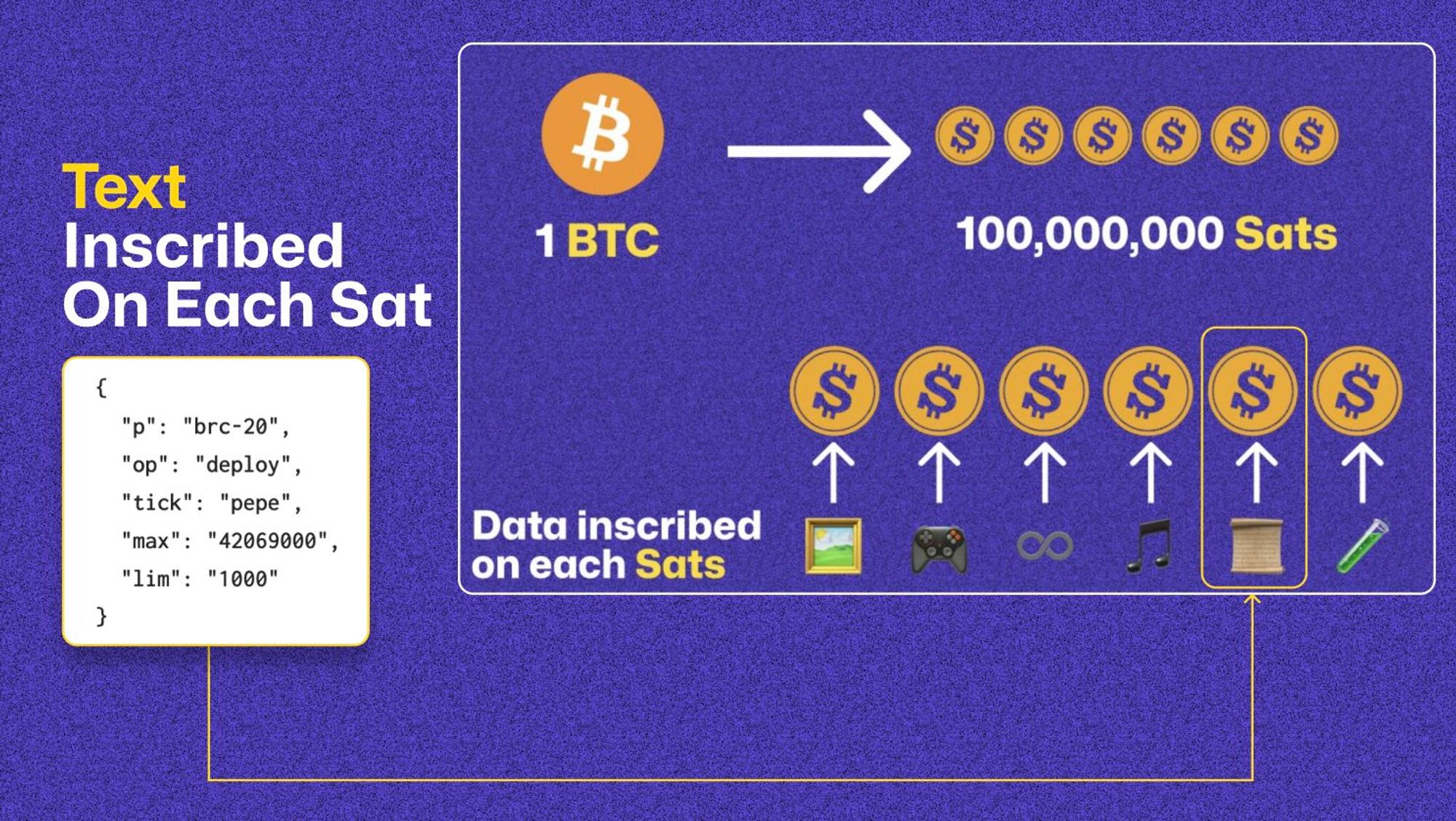
How Bitcoin Ordinals works
This sparked the idea of creating Bitcoin Ordinals by Casey Rodarmor by recording data such as images, text, sounds, etc. into each Satoshi on the output of unspent or remaining transactions. called UTXO. The appearance of Bitcoin Ordinals initially did not receive much attention, until developer Domo launched BRC 20 based on the Bitcoin Ordinals protocol by writing text data containing JSON code into each Satoshi and has since creating a new trend on the Bitcoin network.
What is BRC 20?
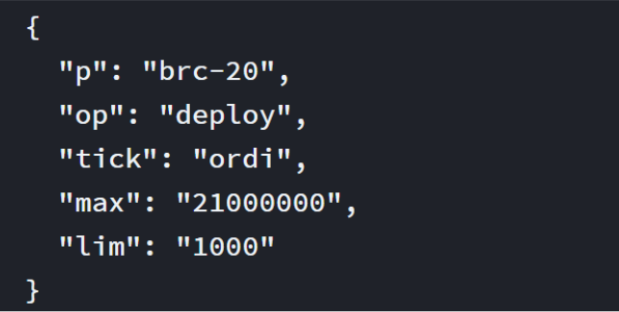
BRC 20 token standard
Considering the name BRC 20 is an imitation of Ethereum ERC 20 shows that they have the same function of creating tokens on the Bitcoin and Ethereum networks but in essence they are quite different. In addition, because the Ethereum and Bitcoin networks themselves are different when Ethereum supports Smart Contracts and Bitcoin does not, the application scenarios of tokens created based on these two standards are also very different. So I will give some comparisons between BRC 20 and ERC 20 so that everyone can better understand BRC 20.
- First the BRC 20 tokens are still essentially Bitcoin NFTs. This means that its value will consist of two parts: The first part is the market value of Satoshi himself, and the second part is the individual value of that BRC 20 token given by market consensus. So even if the market stops paying for BRC 20 tokens at some future date, each BRC 20 token still has its own value as a Bitcoin. But this does not happen with ERC 20 tokens because each token is priced according to market demand.
- BRC 20’s Deploy and Transfer method provides a fairer environment than issuance on ERC 20 tokens. This is because everyone can participate in the Deploy process of BRC 20 tokens while for tokens ERC 20 then it is relatively easy for project initiators and investors to get tokens in advance.
- Finally, BRC 20 does not use Smart Contracts, so it is difficult to create rich scenarios in using tokens like in the Ethereum ecosystem.
BRC 20 Has Become An Important Driving Force To Promote The Development Of The Bitcoin Ecosystem
According to data provided by The Block, since April 20, 2023, driven by the explosion of BRC 20, the number of Transactions on the Bitcoin network has increased sharply with transaction volume nearly doubling in less than a full month. Gas fees on Bitcoin’s network increased even more by nearly 10 times in less than half a month. In addition to the recent wave in April 2023, the recent popularity of ORDI has also caused the number of Transactions and transaction fees on the Bitcoin network to increase sharply again, nearly equal to the old peak set in May 2023. Last.
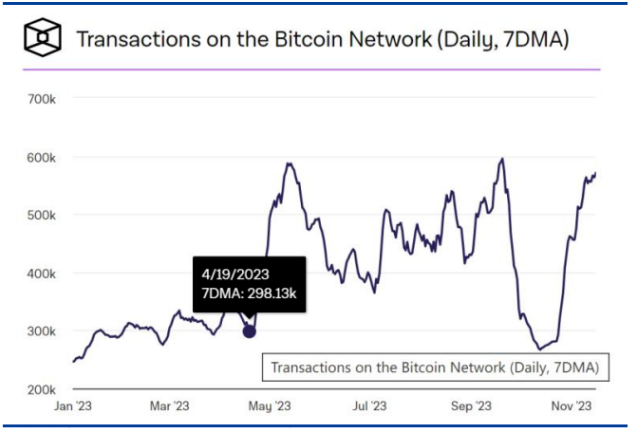
Number of Transactions on the Bitcoin network
Obviously, transaction fees and the number of Transactions of the Bitcoin network this year are greatly affected by the explosion of BRC 20. As part of the Bitcoin Ordinals ecosystem, let’s look at the operating data below. Let’s see if there’s anything special about other pieces in the Bitcoin Ordinals ecosystem.
Ordinals NFT – a simple copy of an NFT
According to data provided by Dune, since the release of the Ordinals protocol in 2022, the minting volume of NFT Inscriptions has increased rapidly, and the growth rate in recent times has been even more astonishing. Up to now, the single-day mint Ordinals NFT volume has peaked at more than 410,000 and the total mint Bitcoin Inscriptions volume has reached nearly 42 million.
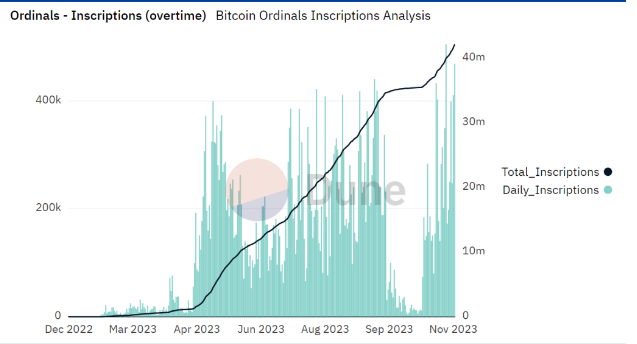
Volume Mint Bitcoin Inscriptions
Currently, there are quite a few NFT projects appearing in the Ordinals NFT ecosystem, here are some typical projects:
- Bitcoin Punks: The first NFT project to successfully upload images in CryptoPunks on Ethereum to the Bitcoin Blockchain using Ordinals. The collection includes 10,000 different 8-bit pixelated character avatars, each with different attributes and rarities.
- Oridinals Punks: A tribute to CryptoPunks, Ordinal Punks is a collection of 100 NFTs where each NFT is a 192 x 192 pixel image created using an open source algorithm by anonymous Web3 creator FlowStay.
Due to the growing demand of Ordinals NFT in the market, this has prompted the birth of several Ordinals NFT trading platforms. Currently there are several popular platforms such as Unisat, OKX NFT Marketplace and Magic Eden. According to data provided by Dune, the highest daily trading volume of Ordinals NFT since May 2023 has exceeded 15,000. Before November 2023, Unisat was the platform with the largest market share, however since the recent boom of BRC 20, OKX NFT Marketplace has grown rapidly and risen to become the leading platform for trading Ordinals NFTs.
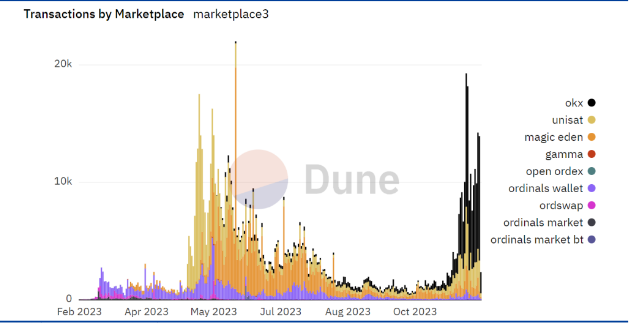
Number of Transactions Ordinals NFT on exchanges
Currently, Ordinals NFT brings a separate story when on the one hand it takes advantage of the natural heterogeneity of Satoshi on Bitcoin and on the other hand it is a simple copy similar to NFT on major Blockchains such as Ethereum, Solana,.. .
BRC 20 Token – relies on Meme culture to create hype
According to Unisat’s statistical data on BRC 20 tokens, as of November 29, 2023, more than 50,000 BRC 20 tokens have been deployed. This rapid increase comes from the explosive trend of BRC 20 tokens such as ORDI, Sats, Rats,… recently. However, one thing to note is that basically the majority of BRC 20 tokens are Memes and are dominated by speculative activities.
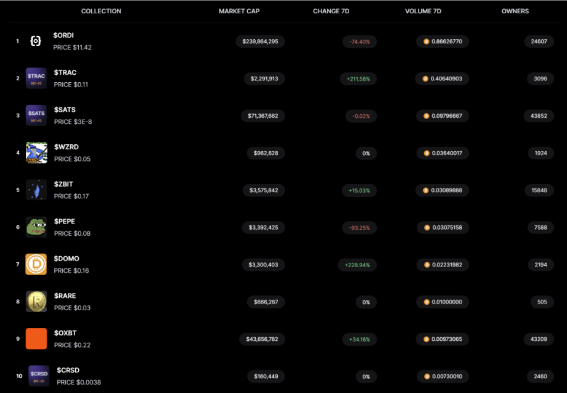
BRC 20 Tokens stand out in the market
Because BRC 20 tokens are basically NFT Ordinals with text data used to engrave on Satoshis, I will provide the following statistical data to see the popularity of BRC 20 tokens.
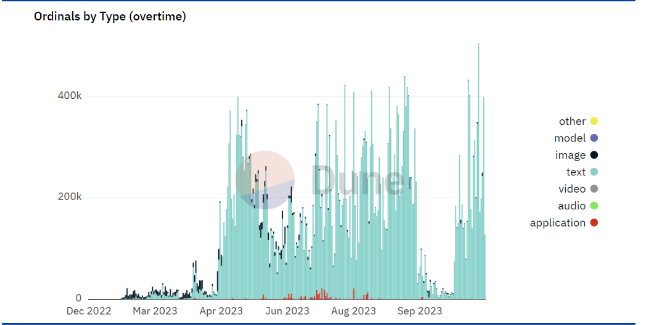
BRC 20’s Market Share in Ordinals NFT’
From the statistical data above, we see that the majority of Ordinals NFTs are in text form, or in other words, BRC 20 holds the majority of the market share in the Ordinals market through both recent booms. In recent times, BRC 20 Token trading volume has sometimes exceeded half of Bitcoin’s total daily trading volume.
Domain name system on the Bitcoin network
Recently, a number of domain name service providers have appeared on the Bitcoin network – a domain name system similar to ENS on Ethereum that helps convert complex wallet addresses into easy-to-use text formats. fully readable and user-readable. Currently, there are two main BTC domain name systems on the market: Bitcoin Name System (BNS) based on Stacks Network and domain name project based on Ordinals.
For BNS based on Stacks Network is a network system that can link Stacks usernames to off-chain state without relying on any central node. In BNS, there is no name collision allowed, meaning that no two users have the same name on the system. In addition, because Stacks is a Layer 2 on Bitcoin that can deploy Smart Contracts, BNS also supports Smart Contracts, but one thing to note is that BNS will not be able to interact directly with the Bitcoin network.
For Ordinals-based domain names, there are currently two popular projects: Sats Names and BTCDomain in which Sats Name can generate “.sats” domain names and BTCDomain can generate “.btc” domain names. Since they are domains based on the Ordinals protocol, the process of deploying domains is similar to that of Ordinals NFT but the engraved content is text in JSON format. Once the minting process is complete, the user’s domain name data will be completely stored on the Bitcoin network.
Exploring ORC 20 and BRC 21: The Innovation Needed to Help the Bitcoin Ecosystem Thrive
To solve some of the problems with the BRC 20 token, community developers have launched new standards such as ORC 20, BRC 21 and other protocols to improve it. Taking ORC 20 as an example, it mainly uses the UTXO model to ensure the prevention of double spending in transactions, allows transaction rollbacks, and supports migration from BRC 20 to ORC 20. Of course, the results of ORC 20’s efforts to move closer to ERC 20, allowing the deployment of dApps on the Bitcoin network.
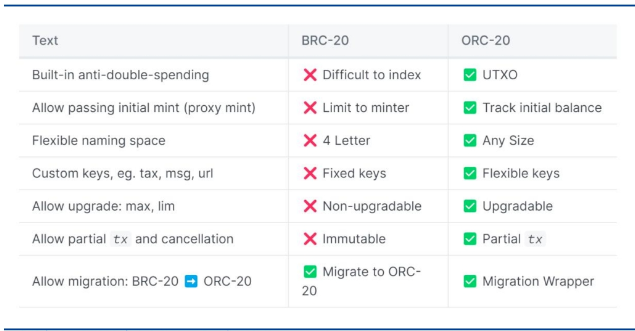
Advantages of ORC 20 compared to BRC 20
As for the BRC 21 standard that appeared later, it is basically a cross-chain project. The BRC 21 standard was proposed by Interlay founder Alexei Zamyatin on twitter on May 7, 2023, and the BRC 21 standard document was released subsequently. Cross-chain assets like WBTC “map” Bitcoin onto the Ethereum network while the BRC 21 protocol maps assets from other decentralized Blockchains (like ETH, USDT,… on the Ethereum network) to be “mapped” ” to the Bitcoin network, making the asset available for use on the Lightning Network.
However, in the end, the Bitcoin network does not have Smart Contracts like Ethereum. Currently, there is no protocol for operating assets on the original chain such as AMM, Lending… and Layer 2 on Bitcoin cannot be compared to Layer 2 on Ethereum, so completely imitating the innovation of the Ethereum ecosystem is difficult. may not be feasible. The development of the Bitcoin ecosystem requires changes based on the inherent characteristics of Bitcoin.
summary
BRC 20 indeed brought innovation and hype that helped usher in a new trend on the Bitcoin network. Above is all the information I want to provide in this article, hope everyone has received useful knowledge.


